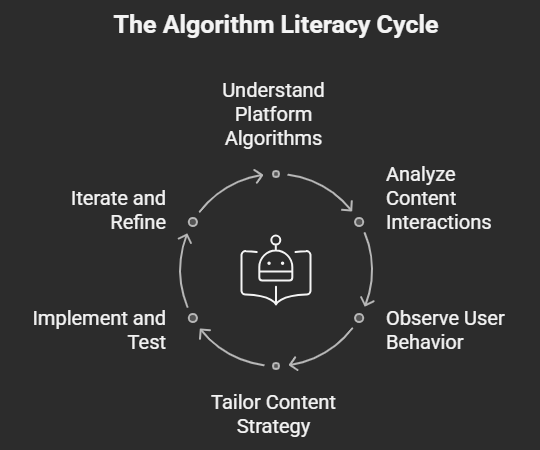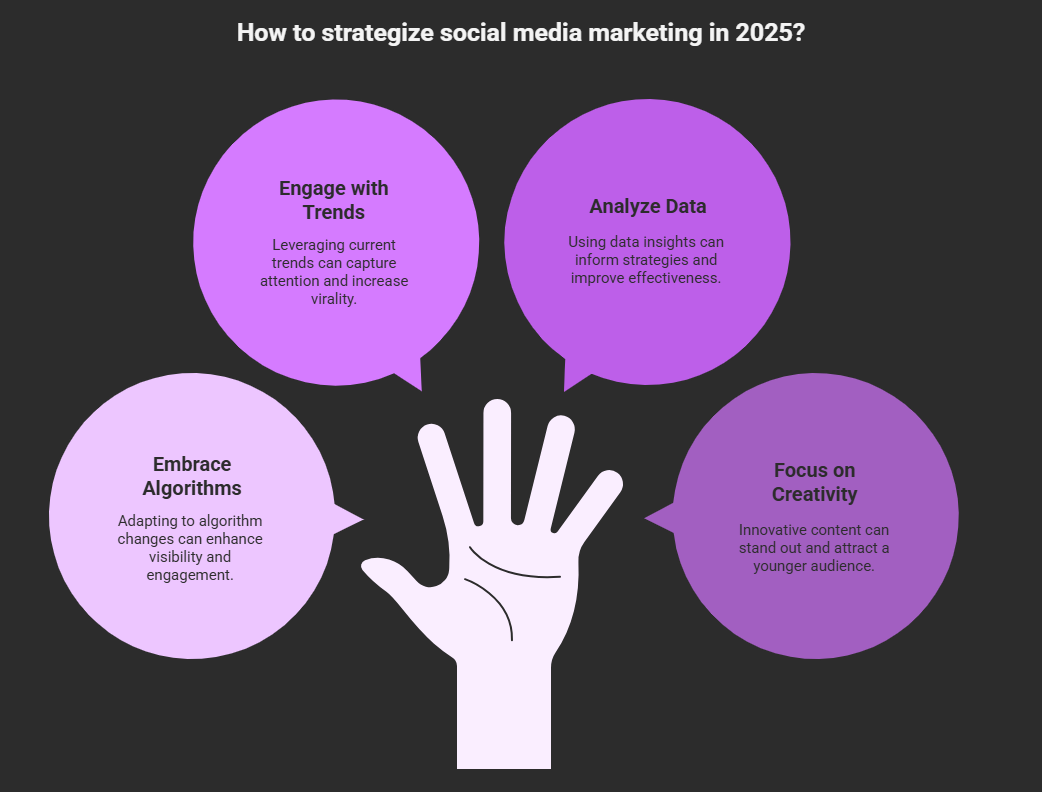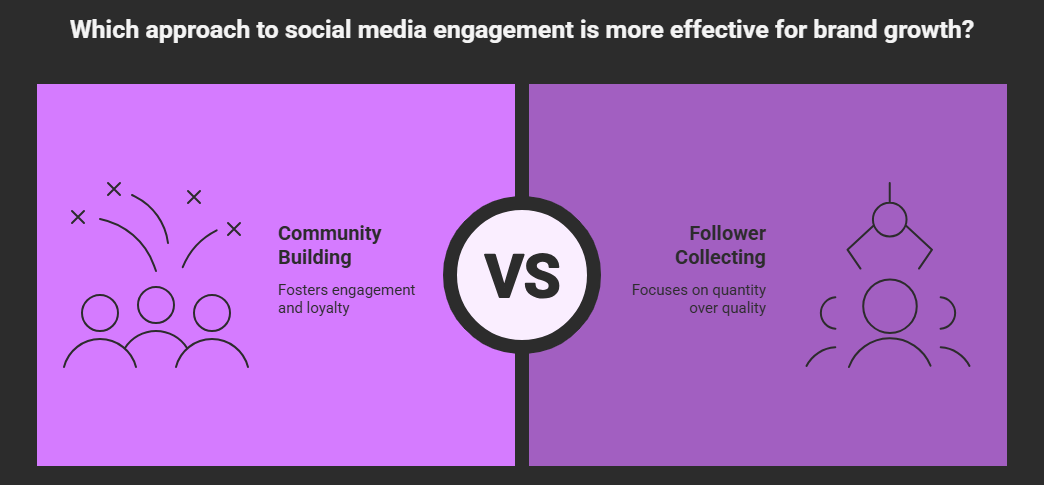Social Media Marketing: Strategies That Actually Slap in 2025

Do you remember those days when social media marketing was posting an adorable photo of the office dog and going home? Yeah, that era has been dead longer than wired headphones. The social world is now a high-stakes game of chess where algorithms evolve faster than TikTok virality, and brands have to contend with literal kids with ring lights in the bid to win eyeballs. Even in this digital madness, some brands are simply killing it, and others are still sharing inspirational quotes on Linkedin and asking why they are away in the engagement ghetto. The difference? Strategizing is not about feeling but about what moves the needle in the social media ecosystem in 2025.
The Attention Economy: It's Brutal Out Here
To get serious for one minute, an average human spends time equivalent to around 300 feet of printed material daily as they go through web pages. That is higher than the Statue of Liberty, and your brand post will be only one small pixel in that never-ending scroll.
Never has the battle to capture eyeballs been fiercer as there are more than 4.9 billion users on social media, and the generation of content is growing exponentially yearly.
We are in an era of economists termed as peak attention scarcity. Your prospective customers are no different as they have only 24 hours available but are being barraged with messages in every possible outlet. It is no longer a matter of being visible but making the post so compelling that people even stop scrolling, which has become more difficult than finding someone who did not hear about the newest online scandal.
Algorithm Literacy: The Skill Your Marketing Professor Never Taught

Do you recall the 4Ps of the marketing? There is now an unofficial 5th P: Platform Algorithm Proficiency. And this concept might change within 37 seconds, unlike those concepts in the textbooks.
Every platform has developed its digital ecosystem. TikTok's algorithm prefers watch time and completion rate above all. Instagram focuses on signs of relationships and saved content. The LinkedIn algorithm promotes posts with approximately early interaction within particular time frames. And Twitter/X believes in conversation and debate (ever so slightly over the top on this).
In 2025, the winning brands are not merely content creators; the winning brands are reverse engineering algorithms. They realize that performing at 2 PM on Tuesday is not a tactic; it is hygiene. The actual approach consists of realizing the interactions between various forms of content, engagement types, and reader behaviours with the platform-specific distribution system.
Take the example of Duolingo. Their mascot, an owl, became TikTok famous not because they had huge budgets but because they realized that TikTok rewards slightly unhinged material that feels like it belongs on TikTok rather than marketing. In the meantime, brands that continue to share identical content on all platforms appear to arrive at separate parties in the same outfit, which is embarrassing and blatant.
Community Building > Follower Collecting
Twist of the plot: your following is much less important than you believe. One thousand engaged fans in 2025 will be endlessly more valuable than the 100,000 ghosts who followed you in that giveaway three years ago, and since then, they have not been engaged.
Intelligent brands have left the old broadcasting approach to community building. They are assembling exclusive Discord channels for the super-fans, labelled Reddit groups where UGC flourishes, and comment sections resembling befriending rather than customer service platforms.
They are creating material that promotes in-house humour and belonging to the same language that causes fans to feel as though they are members of an inner circle instead of advertisement prospects.
This led Glossier to create a billion-dollar brand and change its approach to creating products that seemed like a suggestion of friends but not like a corporate product.
The social approach is based on their comments as conversations, emphasizing customers and making the followers feel a part of something unique instead of the marketing process.
The brands that continue using social media as a megaphone are discovering that followers who are not part of their community are a vanity number on their monthly reports.
The Authenticity Paradox
The thing is that authenticity in 2025 is something everyone realizes is a great idea, but someone does not know what it is or what it means.
Authenticity does not mean that you should post an unedited picture and tag it as real; it is a question of consistency, which is what your brand expresses, teaches, and cares about.
Actual authenticity demands open communication at involved times. It requires organic involvement in the cultural experiences instead of blatantly jumping on the bandwagon.
It requires content produced by human beings and not marketing robots and principles that will not shift depending on the direction the culture winds are blowing.
Patagonia does not sound genuine since they sometimes publish the news about climate change. They are authentic since their supply chain to marketing is geared to their values in environmentalism.
Their social posts are effective because they do not hoist a flag of pretend relatability; they just are as they already have been.
The most cringeworthy on social media is when brands pretend to be authentic instead of being authentic.
Your readers possess advanced BS detection capability and know how to sniff out a bogus post no less than twelve platforms away.
Content Ecosystems > One-Off Posts
Random, unrelated posts are the things of the past (hallelujah).
In other words, successful brands in 2025 are already thinking about connected content ecosystems, in which different forms of content serve each other across platforms and get users to spend more time and be more engaged.
One core content, say a thorough case study, could give birth to:
- a TikTok series of important takeaways
- an Instagram carousel of the best discoveries
- a LinkedIn publication of business insights
- a Twitter thread of fascinating numbers
- a YouTube video of client interviews
- a Pinterest infographic of the data highlights
This ecology system implies that your content will be more active and will establish various approaches to your brand.
Importantly, it also considers the native platform of each platform rather than sloppy cross-posts of the same content across.
Hubspot is the master of this strategy by atomizing insights, which is built by producing comprehensive marketing reports and atomizing those insights on different platforms in a most platform-relevant approach.
Their TikTok does not have the same vibe as their LinkedIn, which is unlike their blog, but still, all paths end with the same worthwhile thoughts.

The Creator Collab Revolution
The boundary between an influencer and a creator has never been thinner.
Yet, one thing is clear: collaborating with the right creators has become a necessity, not a pleasant initiative.
We, however, have come a long way past the face-value sponsored post.
By 2025, the best brand-creator relationships will consist of long-term collaborations instead of single promotions.
They are not too prescriptive but collaborative and based on a real product affinity as opposed to audience measures and not to the number of followers it has but the quality of the content.
Fenty Beauty, created by Rihanna, learned this lesson fast and established connections with beauty creators and makeup artists who were truly in love with the products, as opposed to wooing celebrities.
This led to a genuine form of advocacy, which amounted to actual sales and not mere exposure.
Brand-creator partnerships have become the most successful in which the creators are increasingly becoming creative partners as opposed to distribution channels.
They are putting the creators on equal footing with the product developers, strategic thinkers, and people who plan campaigns and involve them in all the stages, not simply giving them a brief and hoping that something good comes out.
Data-Driven Creativity (Not an Oxymoron)
By 2025, it is a big myth that should be broken that creativity and data are somehow counter to each other.
The winning brands on social know that creativity, not data, should define them.
Even post timing is no longer the only thing that smart social teams are A/B testing and analysing performance patterns using AI tools.
They are creating outlines of content ahead of time using engagement metrics and establishing reviews and channels of communication between their creatives and analytics so that no insight is lost through the filters.
The Wrapped campaign by Spotify is a perfect example of such. It is highly data-focused and uses personal listening numbers to produce emotionally engaging, utmost shareable content.
The campaign is effective because the data makes the creativity work instead of pinning it down.
The outdated structure of the idea generation process (a creative team, an analytics team) causes a fatal disjunction.
This synergy spells out a combination of both creativity and effectiveness in the content produced.

The Social Commerce Evolution
Do you remember when social commerce was done by placing links in weird comments? How we have moved on.
By 2025, the discovery-to-purchase journey will never be easier, and the platforms will be flooded with investment into native shopping experiences.
The best social commerce tactics develop entertaining, shoppable content whereby selling is the secondary choice.
They take advantage of live selling events marrying fun and consummation and incorporate user-generated content as in-purchase social proof.
They develop remarketing chains that are not stalkerish but helpful and a journey that is not coerced.
The example of beauty brand Rare Beauty shows that this strategy has been perfected, delivering TikTok videos that are informative but also fun or beautiful at the same time and promoting products in a very modest way.
People who leave comments in their posts request to know the shade instead of whining that they were sold to—the holy grail of social selling.
The brands that continue to put social commerce as a secondary consideration are leaving big money on the table.
When well implemented, content commerce is useful and not intrusive, making the customer experience smoother.
Micro-Trends vs. Macro Strategy
Truth bomb: pursuing every possible social media trend is quite tiring and useless in the long run.
The brands that will succeed in the long run in 2025 have discovered how to balance attention to keep up with reactive trends and proactive strategy building.
This implies creating the right requirements as to what trends fit your brand and creating a content calendar that is both structured and flexible.
It demands establishing systems to exploit any opportunity within a short period with long-term figures in mind rather than temporary increases in engagement.
The Duolingo social team has perfected this balance, engaging in trends that suit their somewhat maniacal version of the owl character.
However, don't lose any consistent brand voice beyond any single trend. They do not intend to do everything—which works for them fabulously.
The most sustainable one will be to develop a clear system of opportunistic decision-making with a speedy approach instead of mindless adherence to every trend in the feed.
Final Thoughts: Social Excellence Is a Moving Target
What works today in social media marketing will not work tomorrow. By 2026, the platforms, algorithms and behaviour of users will have changed to something new in 2025.
The successful brands, in the long run, are not only those who are and will be the best at current best practices but also those who are developing flexible systems and mentalities.
This involves the culture of trying out and learning simultaneously, the construction of dynamic measurement platforms, and the termination of goals.
It must create knowledge that can span different platforms and approaches and build content systems that bend with shifting distribution forms.
The greatest talent is not being able to master the contemporary algorithm but rather the ability to adapt quickly to fluctuations of the future.
That involves shifting focus from the tactical implementation of action to strategic thought that can fill the course of continuous change.
We do not know how social media might be when you eventually read this blog.
Still, brands with a firm identity, sincere connection with the community, and flexibility with systems will prosper regardless of which platform takes off or disappears.
Latest Posts

Brand-Led Marketing & Visual Storytelling That Connects
Discover how brand-led marketing and visual storyt...

How to Use AI for Content Brainstorming Without Getting Stuc...
Learn how to use AI effectively for content brains...

SEO in 2025: Adapt or Get Left on Page Two
Learn what works (and what fails) in SEO for 2025....
